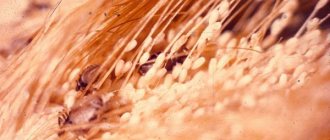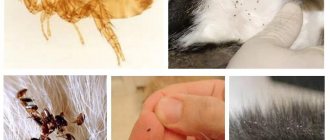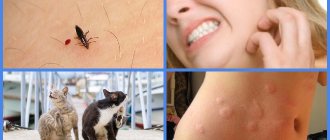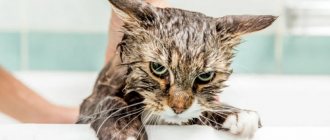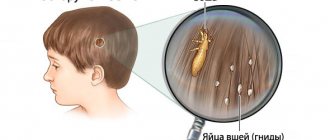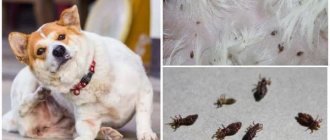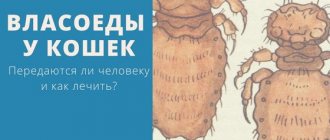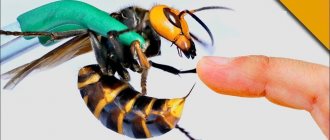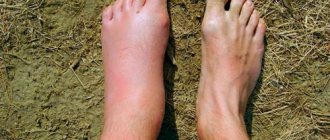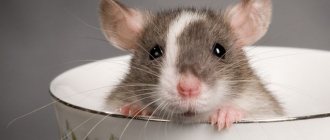Pets have a variety of parasites, both external and internal. But if fleas are on everyone's lips, then lice are considered an exclusively human problem. Lice, or pediculosis, occurs in kindergartens and summer camps. A child can catch an infection by using, for example, someone else’s comb.
However, both cats and dogs can also be parasitized by these annoying insects. The good news is that lice are strictly species-specific parasites. This means that cat louse cannot live on a person or dog, and human louse is not dangerous for pets.
Lice in dogs
“Lice” are popularly called any small insects that cheerfully rustle in a dog’s fur. However, only a veterinary dermatologist or a very experienced dog breeder can distinguish a true dog louse from lice-eaters. These are completely different insects.
Sucking louse
(true louse) bites through the skin to feed on the host's blood.
Biting louse
(hair eater) feeds on desquamated particles of the epidermis, causing more severe skin irritation. It parasitizes on the head, neck and tail, around natural openings. Infestation with lice eaters is called trichodectosis, and infestation with lice is called siphunculatosis.
Infection usually occurs through close contact between animals, but is also possible through contact with contaminated objects, bedding, and surfaces. Lice most often occur in puppies.
Symptoms:
- intense itching;
- the appearance of crusty papules on the skin;
- hair loss;
- peeling of the skin, signs of dry seborrhea;
- tangling of fur and matting in tangles in places where lice hide.
Routes of infection
Lice can occur in any breed of dog except hairless dogs. The presence of fur is the only condition for the appearance of lice. These insects have such a structure of their legs that they can only move along hairs. They can cover a small distance on another surface, but on wool they move much more quickly. Moreover, the dog can be short-haired, but dogs with long and thick hair are especially affected by lice.
As stated, dogs can only get lice from other dogs. These insects do not appear from humans, cats, other animals and birds. The ways in which lice in dogs are transmitted from individual to individual can be different:
- with direct contact - on a free run, on the playground, in training;
- when hunting canids, for example, foxes;
- in dog hotels, shelters;
- in grooming salons with insufficient processing of tools, furniture, bedding;
- from mother to puppies.
Owners can bring dog lice on their clothes or shoes, grooming items, and other items. A dog louse can survive outside a dog's body for about three days, so the infestation may be "distant".
Diagnostics
Signs of lice in animals resemble allergic dermatitis caused by fleas. Diagnosis is complicated by the fact that a pet can have both fleas and lice at the same time. Sometimes infection is accompanied only by slight peeling. Lice can be identified by careful examination of the skin and fur.
Lice appear as dark, oval-shaped objects. Lice eaters move quickly and are very difficult to catch. Body length – 1–1.5 mm. The sucking louse is less mobile and larger – up to 2 mm. You can see nits - lice eggs attached to the fur.
Appearance of parasites
In order to promptly identify parasites in an animal, it is important to know what dog lice and insect nits look like. Unlike fleas, for example, they have a yellowish body color and an elongated head and abdomen. Insects do not have the ability to jump .
Their source of nutrition is lymph, the blood of an infected animal. When laying eggs, the female attaches eggs to individual hairs, which leads to the appearance of tangles in the wool.
The danger of lice and lice for cats and dogs
Lice and lice-eaters themselves are not very dangerous, but the consequences of their parasitism can be very serious.
- Cucumber tapeworm infection
. Like fleas, cat and dog lice eaters are intermediate hosts of tapeworms. An animal becomes ill by swallowing an infected insect while biting it. Young children who are in close contact with pets can become infected with cucumber tapeworm. - Severe exhaustion
. Due to itching, animals cannot rest and eat normally and become nervous. Puppies and kittens become weaker, lose weight, and lag behind in growth and development. Infected dogs may experience anemia due to the high number of bites. - Secondary skin problems
. Inflammation of the skin and self-injury during scratching cause secondary pyoderma (reproduction of pyogenic microflora). A complex of allergic reactions to parasite bites leads to severe dermatoses. - Infectious diseases.
There are few of them, they are rare, but they are especially dangerous (for example, tularemia).
Can they get infected from humans?
Lice cannot pass from a person to a dog. Such parasites feed only on human blood; they simply cannot survive on a dog’s body. Even if a few human lice get on an animal, they will die within a few days.
What to do if a child has one?
If a child or other family member becomes infected with head lice, there is no need to treat the animals. Head lice cannot pass from humans to pets.
Are they transmitted to people?
A person cannot get lice from a dog. There are many types of lice, but each type of animal has its own. Even if the parasites penetrate a person, they can become fully parasitized and die.
Treatment
Lice are easily killed by insecticides, so getting rid of them is usually not difficult. If the pet is kept in an apartment, it is washed with anti-parasitic shampoo (for example, Lugovoi), and after 3 days, a flea and tick drug in the form of drops is applied to the withers or an insectoacaricidal collar is put on. When washing, contact of foam with wool and skin should be 5-7 minutes.
For kennel dogs or aggressive cats, they are limited to applying spot-on preparations (“Bars”, “Bars Forte”) to the skin. This is enough to kill insects. You can use insectoacaricides in spray form.
Since the shell of eggs (nits) is very durable and not all insecticides penetrate through it, preference should be given to long-acting preparations.
Lice and lice more often affect young animals, and when choosing a drug, you need to take into account not only the body weight, but also the age of the animals. Bars Forte drops for puppies and kittens are approved for use from 10 weeks of age.
If small puppies or kittens, pregnant or malnourished animals are infected with lice, your veterinarian will recommend a special remedy. You need to get rid of parasites in any case, but it is important to avoid side effects from insectoacaricides.
If an outbreak of trichodectosis or siphunculatosis occurs in a nursery or shelter, it is rational to use a product that is suitable for treating not only the animals themselves, but also the premises - “Delcid”. It is an insectoacaricide from the pyrethroid group.
Before use, consult a veterinarian.
How to understand?
Lice in dogs are most often located around the eyes and anus.
As a result of lice bites, irritation forms on the skin of a pet, and as a result, dermatitis. Infected individuals have dry and dull fur, which begins to fall out over time. If you wet a dog's fur, it will give off a specific smell.
Additional signs
Signs of lice:
- anemia;
- strong tooth;
- hair problems;
- presence of nits.
Anemia is manifested by the fact that the animal's mucous membranes of the mouth and eyelids begin to turn pale. In particularly advanced cases, there is a risk of losing a large amount of blood. As a result, the dog may experience hypovolemic shock, which manifests itself in the form of diarrhea and vomiting.
If the dog has a lot of mats, then this indicates the presence of a large number of parasites.
Are bites different from flea bites?
Lice bites cause severe itching. There is irritation at the site of the bite, which the dog constantly scratches. With severe damage, alopecia may occur. Often dogs try to comb out the affected areas, thereby injuring them and causing infection.
Prevention
Regularly scheduled flea and tick treatments protect your pet from lice attacks. However, insectoacaricidal preparations are traditionally used only in the warm season, so in winter lice and lice have a chance to settle on a dog or cat. The owner himself can serve as a carrier of parasites, bringing them into the house with the hair of infected animals on his clothes.
For prevention it is necessary:
- limit your pet’s contact with stray animals, and if this is not possible, use drops or a flea collar;
- Do not pet street cats or dogs. If you come into contact with an animal while visiting, you should wash your hands upon returning home.
Are different species dangerous?
There are several types of lice on dogs. Main varieties:
- lice eaters;
- elk;
- chicken;
- white.
lice eaters
Lice eaters have a flat body that grows no more than 2 mm. They have a pale yellow tint. Outwardly, they may resemble ordinary lice. The main difference is that lice eaters have a quadrangular head shape, which is much larger than the body itself.
Moose
Moose lice feed only on the blood of warm-blooded animals. They are most often found in moose and cattle, but sometimes they can be diagnosed in dogs.
Chicken
The chicken type of such insects is quite rare in dogs. These lice eaters have a flattened body and a chewing jaw.
White
White lice feed only on human blood. If the dog has white grains in its fur, then these are eggs of ordinary dog lice.
Diseases caused by lice
What's scary for a dog is not the lice themselves, but the diseases they cause. Infestation can lead to the following problems:
- Eczema and dermatitis. They arise as a response to irritating substances contained in the saliva of lice.
- Various types of suppuration. Lice bite the dog, the dog itches, pathogenic and conditionally pathogenic microflora enter the wounds, and inflammation develops. And at this time, the dog itches further, tears and contaminates the inflamed areas even more... Under such conditions, an abscess or even phlegmon can easily develop.
- Lice contribute to the development of severe fungal infections. Ectoparasites have an extremely negative effect on the immune system, as a result of which it cannot effectively resist threats from the external environment.
Lice are common carriers of infectious diseases, including:
- Lice can carry worm eggs on their paws.
- These parasites are carriers of many infectious diseases, especially of bacterial etiology.
- Lice can carry leptospirosis.
Interesting! Contrary to popular belief, lice cannot tolerate blood parasitic diseases, because The life cycle of Babesia, for example, is strictly tailored to the physiology of ixodid ticks.
Types of dog lice
Animal lice are divided into 2 categories: blood-sucking and chewing. The chewing Trichodectes canis and Heterodoxus spiniger live on dogs.
H. spiniger is found mainly in tropical regions. Therefore, they are unlikely to infect your pet in Russia. Trichodectes canis is found throughout the world. This type of lice lives on the head and neck. It has a blunt, flat head due to the large mandibles with which the insect chews food.
Among the blood-sucking species of dogs, only Linognathus setosus is affected. They live in cool climates. They have sharper heads and mouths adapted for sucking blood or liquids. Suckers always have more developed claws for grasping hair than chewers. They settle on the neck, where the skin is more delicate, in the area under the collar. They prefer to live on dogs of long-haired breeds.
All lice can cause skin irritation and parasitic itching. The pet scratches or bites the affected area. If left untreated, the dog's hair will begin to fall out.
Important! Trichodectes canis carries tapeworms.
Symptoms
Most often, the action of lice is consistent with lice eaters, and in the summer - with fleas. Hair-free areas appear and expand, and the following symptoms develop:
- depressed state;
- itching, skin rashes;
- nits appear at the roots of the hairs;
- insomnia;
- loss of appetite or refusal to eat;
- dandruff, which indicates moderate lice infestation;
- the dog reacts aggressively to touch;
- dermatitis occurs, crusts form, the pathology transforms into eczema or pyoderma;
- anemia occurs mainly in puppies due to parasites sucking out a significant amount of blood;
- the wool becomes matted and tangles form;
- subcutaneous Demodex and Sarcoptes mites are activated;
- exhaustion.
Answers to popular questions
Let's look at a few popular questions, the answers to which are probably of interest to almost every cat owner:
- Are lice transmitted from cats to humans? As mentioned above, these parasites are specific, that is, they can live only on limited types of hosts. Of course, an attack by lice on a person cannot be ruled out, but a long stay of the parasite on the body is almost completely ruled out.
- How many days do nits disappear after treatment with an insecticidal agent? It should be noted that some drugs do not have a detrimental effect on parasite eggs, which contributes to their reappearance. If the composition of the chosen medicine includes highly toxic substances that have a detrimental effect on the eggs, the death of the eggs occurs within a few minutes or hours after treatment of the cat’s fur.
- Do human lice live on cats? Human lice live exclusively on humans. Of course, accidental invasion cannot be ruled out, but such cases are rather rare.
- What do lice look like on a cat? Cat lice have significant differences from the usual, common fleas. These insects have a more rounded body, colored yellowish. They lack the ability to jump. Nits in cats are round white capsules that can be seen in large quantities on the fur. They are attached to individual hairs, which significantly complicates the process of removing them from your pet’s fur.
It is important to remember that it is much easier to get rid of parasites in the early stages of a cat’s infection.
Timely use of insecticides and preventive measures will help protect the animal from the extremely negative consequences of parasitic infestation.
Are dog lice transmitted to humans?
Interestingly, lice are parasites that are divided into species depending on their habitat. They can only live on the host and other individuals of his species. Therefore, a dog cannot become infected with human lice, and a person, in fact, cannot become infected with canine linognathosis.
But you shouldn’t turn a blind eye to the problem. Lice cause severe itching and dermatic problems in pets. Scratched wounds can become infected and develop into a serious illness without treatment. It is important to diagnose and treat pediculosis in a timely manner.
How can you breed it from a puppy?
The symptoms of lice in a puppy are the same as in a large dog. In order to get rid of such parasites, you need to treat the baby with a special preparation. After the fur has dried, the puppy should be combed well to remove all dead and paralyzed individuals. The collar and bedding should be replaced.
Puppies have a rather weak immune system, so during treatment it is necessary to especially carefully monitor its condition and also give special vitamins. It is important to prevent your puppy from scratching the bite areas, as this can lead to infection.
Treatment: how to rid a dog of lice
Linognathosis
a pet can get it from other dogs or canids (wolves, foxes) during a hunt
.
In addition, lice appear under severe stress, a sharp decrease in the protective function of the immune system, and heavy helminthic infestation. The disease is not rare, so dog breeders know how to solve the problem. Pet stores always stock coat care products, including drops and sprays against ectoparasites.
| Drug name | Approximate cost (rubles) | Mode of application |
| Drops on the withers | ||
| Stronghold | 400-600 (1 pipette) | The required volume of medicine from a pipette (determined by weight) is applied to the dry skin of the withers, after first spreading the hair |
| Frontline | 300 (1 pipette) | Apply medicine to the withers from a pipette |
| Dana ultra | 400-600 (1 pipette) | The medicine is evenly distributed along the spine from the withers to the lower back |
| Sprays | ||
| Fiprex | 600 (250 ml) | On average, 1.5-3 ml per 1 kg of animal is required, spray once on the stomach, ears, body, tail and chest, covering the ears, eyes and face |
| GreenFort Neo | 400 (200 ml) | Spray over the dog (distance 10-15 cm), avoiding contact with mucous membranes |
| RolfClub 3D | 500 (200 ml) | Spray at a distance of 25 cm |
| Shampoos | ||
| Leopard | 160 (250 ml) | After bathing with regular shampoo, apply Bars for 3-5 minutes, rinse with warm water; repeat the procedure no more than once every 5-7 days |
| Lugovoy | 131 (180 ml) | Cover the wetted wool with shampoo (1 ml per 1 kg), leave for 5-10 minutes and wash off the foam. |
| Collars | ||
| Foresto | 1200 | The collar is put on at the beginning of the warm season, the effect is designed for 240 days |
Folk remedies in the fight against head lice are not the most effective measure, but they can be used to complement the effect of the drug.
Herbal infusions will soothe the skin and reduce itching from bites. For 1 liter of water you will need 20-25 dry herbs (wormwood, geranium, tansy, rosemary or eucalyptus), the solution is boiled, filtered and cooled. Treat the cover 2 times a week. If the decoction is weak, you can use it when bathing.
Read a useful article on the topic: “Dandruff in a pet: symptoms, causes, treatment and prevention.”
